VIEW AND DOWNLOAD WORLD TENNIS GAZETTE VOL. 16 NO. 1
By JOHN MARTIN
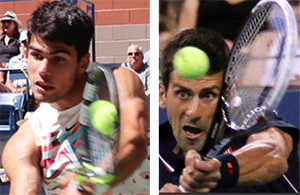
CHAMPIONS FOR THE LONG HAUL?
Carlos Alcaraz, left, and Novak Djokovic are battling for top billing at vastly different ages. Alcaraz ranked number one in world for the first time on Sept 12, 2022, at the age of 19. When he defeated Djokovic, 36, at Wimbledon it appeared he had permanently dethroned Djokovic but the Serb showed he was not quite ready to call it quits.
I have a favorite saying about tennis. It goes like this:
“You don’t quit playing tennis because you’re getting old; you’re getting old because you quit playing tennis.”
I started playing tennis at 14, and these days, in my mid 80s, I step onto a court just about every other day for what I call a 30-minute tennis workout.
As a journalist, I’ve been covering tennis around the world for dozens of years, reporting and photographing matches at the four Grand Slams for The New York Times. The Boston Globe, ABC News, and World Tennis Gazette.
Most fans who follow professional tennis know that at 36, Novak Djokovic is strolling down a familiar path, avoiding retirement as long as possible while pushing back frisky young rivals like Carlos Alcaraz, 20, who took the Wimbledon title away from him and Jannik Sinner, 22, who kept him from the Australian title last month.
“Djokovic needs motivation to stay on track,” said Jon Wertheim, the Sports Illustrated Editor and 60 Minutes Correspondent.
“For the first 15 years of his career, the motivation was obvious, chasing Roger Federer and Rafael Nadal,” Wertheim said. “They set the standard.”
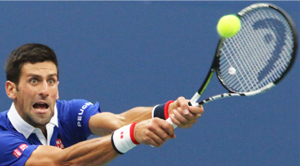
MOTIVATION SEEKER: At 36, Novak Djokovic looks for and finds incentives to stay on top.
What remains is finding a way to stay sharp by looking outward and inward for incentives to challenge himself.
Wertheim spotted several challenges: “Keeping the kids (such as Alcaraz) at bay. Avenging Wimbledon (where he lost to Alcaraz). More recently, Djokovic has defeated Alcaraz by staunchly pressuring the Spaniard at every step.
In a 60 Minutes interview, Wertheim observed, laughing, “You are beating players now, good players, who are closer in age to your kids than they are to you.”
Djokovic chuckled. “I don’t know if that sounds good, but yeah, I think young guys who are very hungry, and very inspired to play their best tennis against me is an additional motivation. I think they kind of awaken the beast in me.”
What awakened the beast in me was my discovery that a 30-minute tennis workout keeps me fit and healthy.
My coach, Tom Svajda, is the top teaching pro at the Pacific Beach Tennis Club in San Diego. His two sons, Zach, 21, and Trevor, 17, are briskly climbing the ladder of tennis in the pro (ATP) and college (NCAA) ranks.
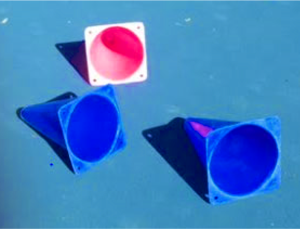
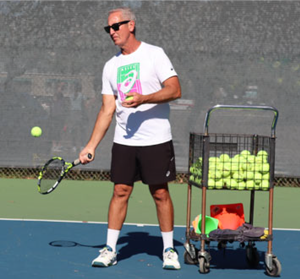
My workout starts with a slow trot around the court. This gets our breathing started and blood moving.
Then, Tom lines up six small plastic cones on his side of the net, three on the forehand side and three on the backhand side. This sets us up to hit as many as 200 volleys.
Tom feeds them to me at the net. As soon as I hit forehand volleys that knock down the six cones, I turn to knocking down six more cones with backhand volleys.
My all-time fastest record knocking down six cones is 11 forehand volleys. At least that’s what I remember, so I checked this with Professor Svajda (Yep, I was right).
Next, we back up on court and begin hitting groundstrokes, forehands and backhands, standing just behind the mid-court service line.
As my balance returns, I hope to move behind the baseline, where I took a tumble some months ago. After my fall, where I scraped my leg, I agreed I should move forward for awhile, until I feel more stable.
To finish my workout, I move to the baseline and begin serving for as much as fifteen minutes and as little as three minutes.
I hate to mention this, but my service toss can be highly erratic. Sometimes I release the ball in exactly the right place: above my head and slightly forward.
But sometimes I hold the ball too long and it sails backward over my head. The results vary. After years of competing with a reasonably effective serve, it makes me determined to get back my control of it.
Recently, my toss began returning! That morning, I began to feel an urge to release the ball at exactly the right moment. My breath took hold (on my silent command) and the ball began to hover in exactly the right place. It began happening in clusters of five or six shots.
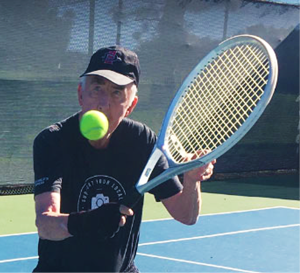
VOLLEYER
I can’t explain it. Coach Svajda deserves the credit. Thanks to his patience, something began happening in my breathing that had disappeared years earlier. He urged me to “place” the ball with a rapid thrust of my arm and an open palm.
I’m determined to keep this happening.
What many tennis fans — aging or not —may not know is that for decades and longer, some of the world’s senior tennis players have continued challenging themselves by playing in tournaments well into their 90s.
In 2000, the national pool of 90-year-olds eligible to play in the USTA 90-and-over men’s championships numbered at least 92 and was growing each year, according to Steve Solomon, the USTA hardcourt tournament director in Palm Desert.
Today, however, buffeted by the ravages of Covid and the challenges of age, the number of 90-year-old men competing has shrunk to 20, and the number of women competing is only 3, according to Tom Ladue, USTA Director of Corporate Communications.
But Bill Kellogg, president of the La Jolla Beach and Tennis Club, site of many 90-plus tournaments over the years, said he thinks the numbers will grow again.
“What I’m expecting is that we’re going to have a few people graduating from the 85s into the 90s here, shortly, and as people age up, they still want to compete; they still enjoy it. We’ve had a couple-year layoff, but I don’t think the competition is dead. I think it’ll come back.”
——-
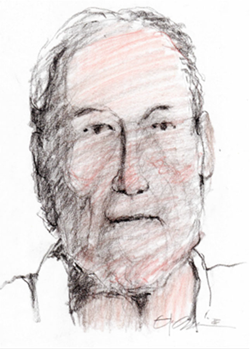
Herman Ratcliffe, 90.
The year was 2000. A national tennis championship was about to begin near Palm Springs. But Herman Ratcliffe was flustered.
The wiry Georgian had just flown into the Palm Springs Airport and discovered that his first-round match in the USTA 90-plus National Hard Court Championships was only two hours away.
“I guess I got it mixed up,” he told a fellow passenger. “I thought they wouldn’t start till tomorrow.”
Two hours later, a quickly hydrated Ratcliffe took the court in 90-degree heat. Three hours after the match started, he won the final point in a three-set victory. He pretended to race to the net so he could jump over, then veered off at the final moment. The crowd roared with laughter – and relief.
“Bubba” Ratcliffe of Hapeville, GA, had turned 90 in January, 2000. A retired paper company shop foreman and manager, he was one of 11 entrants in the second USTA national 90-and-over hardcourt championship. It was played in California at the Mission Hills Country Club near Palm Springs.
The oldest competitor that year was Ken Beer of Hillsborough, CA, 96, a retired Pan American Airlines pilot who flew to Europe, South America, Asia, and was at the controls for the inaugural Boeing 4-motor seaplane flight across the Pacific.
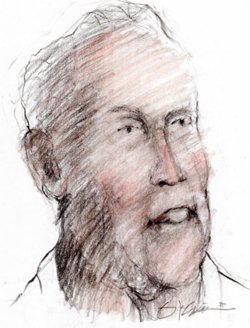
Ken Beer, 96
Beer and Naylor Jones, 90, reminisced before their first round match.
Beer had won the USTA’s first national 90-plus hard-court championship in 1999. After losing in the 2000 semifinal to Ratcliffe, he congratulated his opponent, then sauntered off the court under his trademark straw cowboy hat.
“I’ve got some blind spots on my backhand,” he told a reporter. “I’m going to get some laser (eye) surgery to correct it.”
That attitude does not surprise Kellogg at the La Jolla Beach and Tennis Club.
“There’s a lot of passion in that age group. People don’t realize it, but they’re just as fierce competitors as everybody else.”
One of Kellogg’s fiercest competitors in La Jolla is Rita Price, who turns 98 in June.
“I hung up my tennis rackets two years ago and picked up pickleball,” she told World Tennis Gazette in a telephone interview from the Denver area, where she lives in a senior residence.
“I play pickleball every Friday and Saturday for a couple of hours, and I invite people to be my guest and play,” she said. “We don’t get enough residents that want to play. So, I have to invite my tennis buddies to come and play.”
Nobody knows how much tennis can do to add years to the lives of its players, but there are a lot of positive suspicions.
“It provides the necessary exercise I need,” said Barry Kusnick, 90, a retired engineer who worked on top-secret World War II weapons projects and wrote a best-selling book on sailing, The Boatmen’s Bible. He lived near Newport Beach
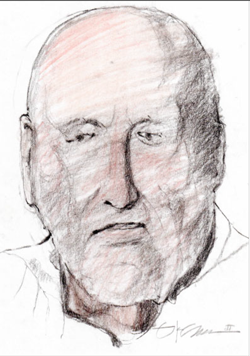
Barry Kusnick, 90
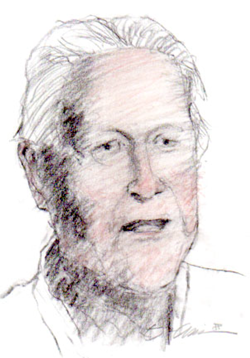
Naylor Jones, 90
“I suspect it keeps me young,” he told me in 2000.
“I hope I can play it until the day I pass on,” said Jones, a retired power station operator from Los Angeles’s San Fernando Valley.
He said he played three days a week. As I watched in Palm Desert, he bounced the ball off the frame of his racquet with perfect muscle control and hand-eye coordination as he walked to the service line.
“I love this game,” he said, sounding more like a television commercial for NBA basketball.
Emil Johnson, 93, of Orlando, FL, called himself “a health food nut,” who watched his diet carefully. An attendant working at Johnson’s assisted care facility, where he lived alone, called Johnson “remarkable” for his ability to stay active.
Johnson won the 2000 USTA 90-and-over Championship, defeating Ratcliffe in the Palm Desert final.
Seconds after he hit the winning point (a cross-court forehand that whipped past his opponent), Johnson’s two great granddaughters raced onto the court to hug his knees (he stood well over six feet tall).
It was a remarkable sight: A tall, smiling man in tennis whites wearing a cap and Lawrence-of-Arabia-style cloak draped across his neck to shield it from the sun. it was a moment of pure triumph, something Andre Agassi or Pete Sampras might experience —- in the year 2065 when they turn 90.
A month later in 2000, Ratcliffe turned the tables and beat Johnson in straight sets (6-2, 6-3) in the final of the USTA National 90 Indoor Championships in Vancouver, WA.
Searching for scientific studies of tennis’s beneficial effects on the body can be almost as difficult as finding a flaw in Pete Sampras’s first serve. The effect of dancing on toes and darting from side to side and forward and back while striking a yellow sphere remains largely uncharted by the National Institute for Aging.
Most of the literature I’ve come across reveals scientists studying men and women still vigorous in the tenth decade of their lives. Beer, for example, told me he would hit 200 balls on a ball machine each morning, then look for a match at nearby courts.
A 1994 study in the New England Journal of Medicine (“Exercise Training and Nutritional Supplementation for Physical Frailty in Very Elderly People”) found that Very Elderly People who carried on high-intensity resistance exercise training were able to counteract muscle weakness and physical frailty.
Pills alone won’t do it, concluded the ten researchers:
“Multi-nutrient supplementation without concomitant exercise does not reduce muscle weakness or physical frailty.”
In 1997, researchers from Harvard, Tufts, the Veterans Administration and a Hebrew Rehabilitation Center for the aged in Massachusetts conducted “A Randomized Controlled Trial of Progressive Resistance Training in Depressed Elders.”
Among its findings: Exercise training reduced depression. The researchers called it “an antidepressant…while also improving strength, morale, and quality of life.” But it wasn’t tennis. Instead of scrambling for drop shots, the elderly subjects (60 and older) worked on machines to press legs and chests, extending and flexing knees.
Would developing a better backhand ease depression?
In 1999, a dozen psychiatrists, physicians, and psychologists from Duke University, the University of Colorado, and the University of California at San Diego conducted a similar study.
“An exercise training program,” they wrote, “may be considered an alternative to antidepressants for treatment of depression in older persons.”
To be honest, I’m not sure where I found the vignettes to follow. But consider this:
A quarter century ago, tennis-playing Harold Wiese, 90, of St. Louis, was chairman of a major truck distributorship in the Midwest. At 96, John Littley of Vancouver, WA, was still pruning his fruit orchards. Littley was a retired Alaska bush pilot who worked as a welder and farmer.
Bob Lawrence, 90, of Santa Barbara, ran his own photo imaging equipment company until he was 80. Wiese and Littley sat out the 2000 tournament, but Lawrence played, losing to Ratcliffe.
Lawrence credited his wife, Myra, with getting him started in tennis at age 69. “She gave me a wood racquet and I started playing,” he said. “I’m sort of competitive.”
Tennis “keeps me alive,” said Lawrence, explaining that it’s a matter of “getting the exercise, having something to do.”
Remember Herman “Bubba” Ratcliffe who stepped off the plane in California and two hours later won his three set, first-round tournament match in 90-degree heat?
Afterward, he sat down for an interview with ABC News, chatting about his love of tennis:
“I like the competition, I like the people, I like their wives,” he said, flashing a devilish grin.
But that wasn’t the end of his day. After our 30-minute interview, Bubba changed into a smart business suit and tie, attended a players’ banquet dinner, and danced with the wives of younger players competing in a USTA 60-and-over tournament.
Then, he stole the show. When the music stopped, he walked up to the stage, pulled out a piece of paper, and recited a poem written by American Folk Singer Pete Seeger:
“I get up in the morning and dust off my wits,
“Pick up the paper and read the obits.
“If my name is missing, I know I’m not dead,
“So I eat a big breakfast, and go back to bed.”
———
There are more than a dozen seniors playing several days a week at the Pacific Beach Tennis Club, where my workouts take place. We encourage each other by waving or saluting every time we pass.
At least one senior is a retired medical doctor. He says it builds his strength and balance to play every day. .
When I told a neurologist about my workouts, he was ecstatic. “Tennis is a perfect treatment” for his patients, including those who struggle with what are called Parkinsonian-like symptoms.
Who knows? Staying on the tennis court and hitting baskets of balls rather than hanging up our racquets may be the wisest thing we can do.
Rene Lacoste, the French tennis champion a century ago, is another example of longevity. He was the first competitor to wear polo shirts and adorn them with images of alligators.
In a 1965 New York Times International Edition interview in his home near the Bois de Boulogne in Paris, he told me the alligator idea came from a Boston sportswriter in the 1920s. Covering a Davis Cup match, the writer marveled at Lacoste’s ability to speedily reach one side of the court and then the other in just a few rapid steps.
You could say Rene Lacoste stayed on the courts for many years. In his 20s, he invented the first ball machine. At the age of 60, he introduced the first metal racquets, one of which became the Wilson T2000, one of the company’s all-time best-selling items.
Lacoste died in 1996 at the age of 92. Longevity? He set a standard!